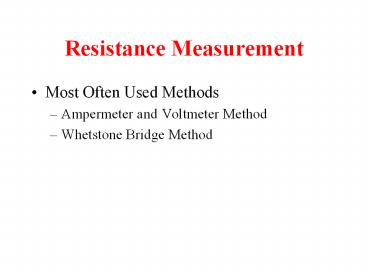Resistance Measurement - PowerPoint PPT Presentation
1 / 26
Title:
Resistance Measurement
Description:
Resistance Measurement Most Often Used Methods Ampermeter and Voltmeter Method Whetstone Bridge Method ... Accuracy depend on the accuracy of instrumentation, ... – PowerPoint PPT presentation
Number of Views:140
Avg rating:3.0/5.0
Title: Resistance Measurement
1
Resistance Measurement
- Most Often Used Methods
- Ampermeter and Voltmeter Method
- Whetstone Bridge Method
2
A-m and V-m Method
- Easy to perform,
- Easy to calculate the resistance,
- Easy to calculate the measurement error,
- Accuracy depend on the accuracy of
instrumentation, - Resistance of contacts influences the results,
3
Two A-m V-m Methods
- V-m Connected in Front of A-m,
- A-m Connected in Front of V-m
- Which method to use when???
A
A
Vs
Vs
V
Rx
V
Rx
4
V-m Connected in Front of A-m
A
Ra
Vs
Vv
V
Rx
Vx
Rv
5
Calculation
- Approximate Value of Unknown Resistance
6
Calculation
Exact Value of Unknown Resistance
Where Vx is
7
Calculation
8
Absolute Error
9
Percentage Error
10
Percentage Error
This methods is used for larger resistance!
11
Example 1
12
Example 1 Calculation
Approximate Value of Unknown Resistance
Exact Value of Unknown Resistance
13
Example 1 Error Calculation
Absolute Error
Percentage Error
14
Example 2
If we use the same circuit to measure
unknown approximate resistance of
Percentage error would be
15
A-m Connected in Front of V-m
A
Ra
Vv
Vs
V
Rx
Vx
Rv
16
Calculation
- Approximate Value of Unknown Resistance
17
Calculation
Exact Value of Unknown Resistance
Where Ix is
18
Calculation
19
Absolute Error
20
Percentage Error
21
Percentage Error
This methods is used for smaller resistance!
22
Example 3
23
Example 3 Calculation
Approximate and Exact Value of Unknown Resistance
24
Example 3 Error Calculation
Absolute Error
Percentage Error
25
Example 4
If we use the same circuit to measure
unknown approximate resistance of
Percentage error would be
26
CONCLUSION
- V-m in front of A-m - for LARGER R
- A-m in front of V-m - for SMALLER R































